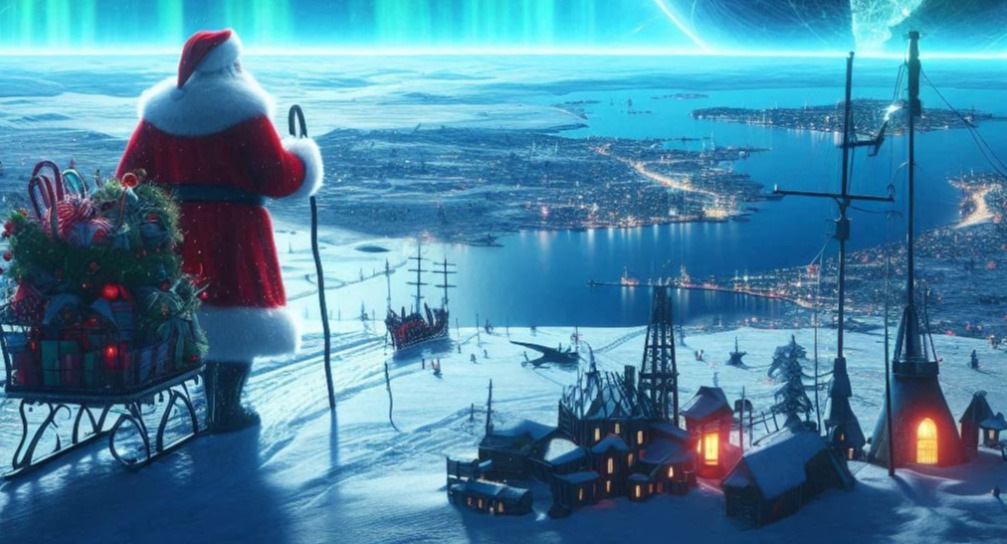THE AMERICAN THESIS THAT SANTA CLAUS LIVED AT THE NORTH POLE: ORIGINS AND EVOLUTION
I. The Birth of the Thesis of Santa Claus Living at the North Pole
1. Early Origins and Traditions: The idea that Santa Claus lives at the North Pole emerged as part of the modern image of Santa Claus. This thesis is based on the understanding that Santa is considered a mythical figure and his place of residence is depicted as a mysterious and remote region. However, this idea has taken shape in modern popular culture and advertising.
2. Dutch and American Traditions: Santa Claus has its origins in the Dutch tradition of Sinterklaas. Sinterklaas is recognized as a figure who brings gifts to children at Christmas time. In the 17th century, when Dutch immigrants came to America, the Sinterklaas traditions moved to America, where they evolved into “Santa Claus”. At first, the exact place where Santa lived was not specified; the figure was often depicted at home or in various locations.
II. Development of the North Pole Thesis
1. 19th Century and Early Modern Age: The thesis that Santa Claus lives at the North Pole first emerged in the 19th century, when the modern image of Santa Claus was taking shape. The 1823 poem “A Visit from St. Nicholas” (New Year's Eve) describes Santa traveling by sleigh and leaving gifts for children during the night, but does not directly state that he lives at the North Pole.
2. 1860s and 1870s: The idea that Santa Claus lived at the North Pole began to gain popularity, especially in the late 1860s. In the 1860s, important drawings and illustrations from this period featured images of Santa Claus living in a remote and inaccessible region, such as the Arctic Peninsula. These depictions reinforced the idea of Santa bringing gifts to children from a mystical place far away from the world.
3. Coca-Cola and Haddon Sundblom: Santa Claus' life at the North Pole became widely recognized with Coca-Cola's advertising campaign in the 1930s. The illustrations created by artist Haddon Sundblom, depicting Santa as a happy, friendly and sympathetic figure, emphasized the theme that Santa lived at the North Pole and sent gifts all over the world from there.
These ads featured the details of Santa living at the North Pole and preparing gifts there. Coca-Cola's depictions in these advertisements greatly shaped Santa's image in popular culture.
III. Cultural and Advertising Evolution of the Thesis
1. Cultural Reflections: Over time, the idea that Santa lives at the North Pole became a popular belief among children and widely celebrated during the holidays. Depictions of him living at the North Pole contributed to the perception of Santa Claus as a mystical and magical figure.
2. Tourist Attractions: Santa Claus' life at the North Pole is also embodied in various tourist attractions. For example, the “Santa Claus Village” in Rovaniemi, Finland, offers an experience of Santa living at the North Pole. This tourist attraction is promoted as Santa's “home at the North Pole” and gives visitors the opportunity to visit and interact with Santa's office.
3. Media and Popular Culture: The idea that Santa Claus lives at the North Pole appears frequently in media and popular culture. Movies, books and television programs depict Santa making toys in his workshop at the North Pole, traveling with reindeer and delivering gifts to children around the world.
The thesis that Santa Claus lives at the North Pole, while not historically rooted early on, has been established in modern popular culture and advertising.
Coca-Cola's advertising campaign in the 1930s contributed significantly to the widespread recognition of this image and the popular belief in Santa's life at the North Pole.
Over time, this thesis became a cultural tradition and led to the perception of Santa Claus as a mystical and attractive figure during the holiday season.

